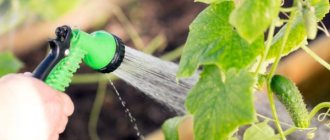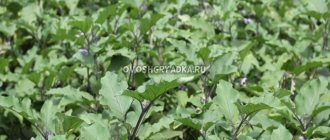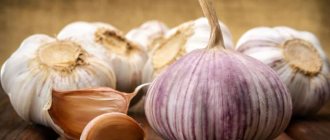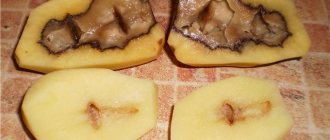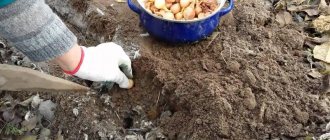Vegetable growing » Eggplant
0
2384
Article rating
Kira Stoletova
In gardening practice, it often happens that eggplants do not set when flowering, although before this the plants developed well. There are many factors that lead to the problem. They consist of improper care. This usually happens when growing vegetables in greenhouse conditions.
Eggplants do not set when flowering
Reasons for the absence of ovaries, falling and lack of fruits in eggplants
Often, due to color drop, the ovaries do not form. Sometimes a plant grows and blooms, but there are too few or no fruits. Let's look at the main reasons why eggplants don't have ovaries.
Temperature violation
The temperature favorable for plants is from +25 to +27°C. If it is below +15°C, growth slows down followed by color shedding. Such temperature changes occur after seedlings are placed in open ground and there is a sharp cold snap. Eggplants do not die, but the color and ovaries fall off.
Hot summers are bad for plants. At temperatures above +32°C, the pollen becomes sterile, and the barren flowers on the eggplant fall off. This occurs when the crop is grown in a poorly ventilated greenhouse.
Reference. Eggplant is a capricious plant that does not tolerate stress well. In the presence of constant drafts or sudden changes in temperature, ovaries do not form on it.
Improper watering
Eggplants are moisture-loving plants, so they die due to lack of water. They require timely watering, since the leaves instantly evaporate moisture. When fruit set and growth occurs, soil moisture should be 75-80%. Drying out the soil and watering with cold water leads to the loss of ovaries and color.
Excess nitrogen
Nitrogen is an indispensable fertilizer for seedlings and crop development. Before flowering of eggplants, its amount is reduced, and potassium and phosphorus are increased.
Important! Excess nitrogen fertilizers cause increased growth of green mass and lack of flowering. If color appears on the plants, it will remain without an ovary.
Excess pollen
Many varieties of eggplant are self-pollinating - the flowers are bisexual. But sometimes too much pollen is produced, which leads to it sticking together. This phenomenon is observed in a greenhouse with a humid environment. This is why eggplants bloom, but there are no ovaries. Experienced gardeners recommend pollinating the plant using a regular brush.
Fertilizer shortage
Plants love nutritious and light soil. Mineral deficiency causes absence of ovaries. A lack of phosphorus, boron or magnesium negatively affects the crop.
Close fit
The density of plantings prevents sunlight from penetrating to the ovaries. Strong shadow causes the plant to shed them.
Unsuitable soil
Plants prefer fertile and drained soil with neutral acidity. Dense, acidic and poorly heated soils interfere with the formation of fruits. This often happens in the presence of loamy and podzolic soils.
Why do the buds fall off?
Sometimes, even if all the rules of agricultural technology are followed, the buds of eggplants fall off. To help a plant that does not set fruit, you need to understand why this happens. There may be several reasons.
- Excess of zinc, copper and other elements.
- Spider mite infestation.
- Stress suffered by the plant - watering with cold water, drafts.
- Lack of light and low temperature in the greenhouse, for example due to prolonged rains.
- Excess nitrogen in the soil.
How to fix these problems
Adviсe:
- Drugs are used. If the eggplants do not form ovaries, they are sprayed or watered with “Bud”, “Gibbersib”, “Epin”. These products contain phytohormones that make plants grow and develop well.
- Pay attention to the amount of fertilizer used . If there is a lot of nitrogen in the soil, potassium and phosphorus components are added. If there is a deficiency of boron or magnesium, the bushes are sprayed with a complex solution. Recipe: 1 g of boric acid is dissolved in 1 liter of water, diluted with 10 liters of water and 1 g of magnesium sulfate is added. Eggplants are fed with Agricola or Kemira.
- If pests are present, the plant is treated with Confidor and Strela . Insects damage the buds, which leads to the absence of ovaries.
- The flower stalks on self-pollinating eggplants are gently shaken . Self-sterile ones are pollinated by hand with a brush.
- Monitor and regulate air temperature. The greenhouses are ventilated during the day and closed at night.
- Water the plants abundantly and in a timely manner - 2 times a week, 2 liters per bush in the absence of precipitation. Use only warm water - cold water inhibits the development of the bush.
Troubleshooting
If the ovaries do not form naturally, the plants are stimulated with various drugs.
For this purpose, the following means are used: Buton, Gibbersib, etc. These substances promote the growth of the crop, as they contain a phytohormone. Plants can produce it themselves, but only if all the conditions required by the culture are created.
If, due to the high nitrogen content in the soil, eggplants do not set in the greenhouse, you need to add substances that soften its effect. For this purpose, potassium-phosphorus fertilizers are used.
It is also worth inspecting the bushes for pests. The Colorado potato beetle and aphids can eat flowers, which will prevent them from setting. Insects are collected by hand, since the use of chemicals in the greenhouse is unacceptable. Vegetables accumulate harmful substances in large quantities.
Prevention measures and advice from experienced agronomists
Experienced gardeners recommend adhering to the following rules:
- Check the soil. For planting, choose light and fertile soil with a neutral reaction. If plants are planted in greenhouses, prepare a mixture of 1 part turf and 2 parts humus.
- Choose the right place. It should be well warmed by the sun. In the shade, the crop will not bear fruit.
- Maintain crop rotation . Eggplants are not planted after tomatoes, potatoes, and physalis.
- Use high-quality seed material. For this purpose, zoned varieties are selected. Planting material is processed to prevent various diseases.
- Forming bushes . Remove bad ovaries and leaves that interfere with the buds.
- Pluck off the yellow leaves and the remains of the corolla from the flower. Otherwise they will cause the fruit to rot.
- Set the recommended temperature. When the temperature drops at night, cover material is used. The greenhouses are ventilated daily, and in hot weather the green mass is cooled by surface watering.
- Water the plants once a week, in hot weather - 2 times. For 1 sq. m area, about 40 liters of water are poured.
- Regularly loosen the soil and remove weeds . Try not to damage the root system.
- Fertilize 3 times during the growing season. Nitrogen fertilizers are used 14 days after the appearance of plants, during the flowering period - complex fertilizers, and during the fruiting period - phosphorus-potassium fertilizers. It’s good if the products contain macro- and microelements.
Experienced gardeners recommend choosing the right eggplant varieties for growing in a particular region. The best of them are:
- Almaz - for all regions of Russia;
- Banana - for central Russia, the Urals and Siberia;
- Epic F1 - for the southern regions;
- Black beauty - for regions with cold climates.
To obtain high-quality soil, phosphorus-potassium fertilizers are applied in the fall. The area is being dug up. In the spring, the procedure is repeated, but without applying fertilizer.
Features of growing eggplants in a greenhouse
Eggplant is a plant of the Solanaceae family, the fruits of which are large, round, pear-shaped or cylindrical berries of gray-green, dark purple or brown-yellow color. The crop is quite demanding in care, and if the basic rules of cultivation are not followed, it will unpleasantly surprise you with the lack of fruiting despite the presence of excellent flowering.
Growing a fruit-bearing plant in a greenhouse is not an easy task even for experienced gardeners.
To successfully cultivate a crop in a greenhouse, several rules must be strictly followed:
- No temperature changes . Eggplants react very negatively to sudden changes in temperature, so when growing seedlings, stable light and temperature indicators should be organized, otherwise the plant will respond by shedding flowers and ovaries.
- High quality soil . The composition of the soil plays an important role in the good development of the crop. The ideal option is light, nutritious, well-fertilized soils, for example, a mixture of humus and turf soil or humus and peat.
- Warmed soil . Seedlings should be planted in well-warmed soil, which will provide the plant's root system with favorable conditions for growth.
- Loosening the soil . The soil for eggplants should not only be nutritious, but also enriched with oxygen, so it must be loosened regularly, going a few centimeters into the soil.
- Watering and fertilizing . “Blues” require strict adherence to the watering schedule, otherwise the flowers will begin to fall off. The first irrigation should be carried out 5 days after planting in the ground, then once every seven days. Water the crop directly “under the bush”, making sure that moisture does not get on the foliage. During the season, eggplant feeding should be done 3-5 times, depending on the condition of the bushes. Fertilizers are first applied 2 weeks after planting. Mineral and organic products are used as fertilizers.
Important! Eggplants simply “adore” organic fertilizers, but you shouldn’t get too carried away with them, since they activate the growth of greenery and inhibit the development of fruits.
Blooms but doesn't bear fruit
What is the most offensive thing for a vegetable grower? Well, of course, lack of harvest. The plants bloom, but the fruits do not set. Most of the questions in reader mail concern this problem with eggplants. Associate Professor of the Department of Vegetable Crops of the Belarusian State Agricultural Academy, Candidate of Agricultural Sciences Anna Gordeeva will help us understand the reasons for this phenomenon.
And the first thing Anna Petrovna draws attention to is that eggplant is a very complex crop: it is not always possible to create comfortable conditions for it, either in a film greenhouse or in open ground. Therefore, flowers will fall off almost always, more or less. But if you take into account all the needs of this southern plant, then the harvest can be harvested to the maximum.
First of all, you need to conduct a soil analysis: eggplant does not like compacted, swampy and cold soils. But on soils rich in organic matter, moisture- and breathable with a neutral reaction (PH 5.5 - 6), it grows magnificently.
The landing location is also important. Eggplants should not be planted after crops of the nightshade family - tomatoes, potatoes, physalis, tobacco and shag. And it can be returned to its original place only after 3-4 years. Therefore, in greenhouses and greenhouses, a kind of crop rotation should also be observed. Or change the soil.
Seeds infected with viruses can also cause failure. Therefore, it is best to plant only zoned varieties.
Poor fruit set may also be the result of poor insect pollination. This often happens in protected ground conditions. Then you will have to carry out artificial pollination. To do this, pollen is taken from the mature yellow anthers of a flower with a brush and applied to the stigma of another flower. The best pollen for pollination is considered to be the pollen of a flower that has just begun to open.
Scheduled meals
Eggplant is a big nitrogen lover. The first feeding is carried out 2 - 3 weeks after transplantation: 3 tbsp. l. azophoska per 10 liters of water and 0.5 liters for each plant. The second - during mass flowering. And after the fruits begin to set, you can add an infusion of manure (1:10), chicken manure (1:20) or weeds (1:5). Previously, you should not switch to natural organic matter: the plant will shed its ovaries. And be sure to add 100 - 150 g of superphosphate per bucket of infused organic matter.
If there are no organic fertilizers, apply 400 g of urea or ammonium nitrate, 500 g of superphosphate and 50 g of potassium sulfate in several doses (at the specified time). Measurement is important when working with fertilizers: if there is a lack of nitrogen, the eggplant will sharply slow down its growth, and if there is an excess of it, it will slow down the formation of fruits.
You should not feed eggplants with fertilizers containing chlorine, ammonium chloride, or potassium chloride.
Despite the fact that eggplant is a nitrogen-loving plant, it also needs phosphorus and potassium.
Phosphorus fertilizers will enhance root growth and the formation of generative organs, and also accelerate the ripening of fruits. With phosphorus deficiency, the plant turns into a dwarf, the buds fall off, and the ovaries develop poorly.
Potassium fertilizers increase resistance to disease. Microelements (especially molybdenum, boron and copper) are also necessary for growth, development and fruiting.
As a rule, weak plants shed flowers and ovaries. To strengthen their immune system, treat eggplants with Epin-Extroy, Ecosil or Novosil.
Destroying Thirst
The reason for the dropping of buds, flowers and ovaries may also be drying out of the soil. The optimal relative humidity is about 60%.
Eggplant is a moisture-loving crop. But with excessive soil moisture, when air access to the roots decreases, the leaves turn pale and yellow, and the buds and flowers very often fall off.
Therefore, watering is one of the main conditions for obtaining a good eggplant harvest. Plants need to be watered every 7 - 10 days, giving per 10 square meters. m 400 - 500 liters of water. The water must be warm - not lower than plus 20 degrees. After the “water procedures,” the greenhouses must be ventilated, and the next day the soil must be loosened. You can also mulch it.
Let there be light!
It is believed that eggplant sets fruit only if direct sunlight falls on the flower. The slightest shading by buildings and plants adjacent to the greenhouse will inevitably lead to crop loss. Or even its complete absence. Additional “lightening” is recommended—tearing off the leaves that cover the flowers. But don’t get too carried away: the main task of foliage is to deliver nutrition to the fruits.
Eggplant is a short-day plant that blooms only when its length is no more than 14 hours. That is, from the end of June, when the days begin to get shorter. Reducing its length to 10 - 12 hours (with high light intensity at the same time) allows you to speed up the onset of fruiting.
Daylight hours can also be reduced artificially. To do this, it is enough to install a frame over the plants and cover it with light-proof material. And you need to remove thick fabric, for example, from 7.00 - 9.00 to 18.00. But if you decide to darken your eggplants, then do it every day. Irregular darkening will only harm the plants.
Warm but not hot
Eggplant, like any southerner, loves to soak up the sun. In terms of heat requirements, it surpasses tomatoes and even peppers. It grows and develops normally only at a temperature of plus 22 - 28 degrees. If the thermometer during flowering rises above plus 30, then the plants almost stop growing, the buds and flowers that have bloomed by this time fall off, and the pollen itself becomes sterile.
Cool weather is also not good for the future harvest: at plus 14 degrees and below, the eggplant generally freezes. It is especially sensitive to lower temperatures during the formation of buds and flowers.
At night the temperature should not drop below plus 12 - 15 degrees. During frosts, plants in greenhouses are additionally covered with hay, lutrasil or spunbond. It has been noticed that at low night temperatures, early-ripening varieties lose fewer flowers and ovaries than mid- and late-ripening varieties.
And if for a long time the temperature drops to plus 6 - 8 degrees, irreversible physiological changes will occur in the plant and you can forget about the harvest altogether.
In cold, cloudy weather, the plant slows down its development and, as if preparing for difficult times, intensively sheds flowers and ovaries. Therefore, if it suddenly gets colder or prolonged rains begin, spray the plants on the leaves with a solution of calcium nitrate - 1 tbsp. spoon per 10 liters of water.
Help "SB"
Eggplant varieties zoned in Belarus and suitable for growing in protected soil are “adona”, “combo”, “patsekha”, “rada”, “Lara”, “orion”, “scorpio”, “kulon”, “bourgeois” , “bull heart”, “maria”, “prince”, “black moon”, “black dragon”, “scimitar”, “long purple”, “black handsome”, “atos”, “cherni prince”, “amethyst” , “taste of mushrooms.”
Soviet Belarus No. 133 (24270). Saturday, July 20, 2013.
Possible reasons
It is quite difficult to achieve fruiting of a plant grown from seeds, even in greenhouses. Often eggplants bloom, but do not set fruit. The reasons may lie in the low quality of seeds or non-compliance with agricultural practices:
- incorrect watering mode;
- soil deprived of nutrients;
- improper lighting;
- temperature fluctuations.
The reason may be poor-quality seedlings or improper cultivation. Young shoots have an underdeveloped root system, which is easily damaged during transplantation. Therefore, in order not to harm the plant, it is better to grow vegetables for seedlings in large containers.
Seed quality
Often, gardeners prefer not to buy ready-made seeds, but grow vegetables themselves to obtain them. Collecting seed eggplants that have not reached technical maturity will not allow obtaining high-quality material. In addition, to obtain high-quality seeds, it is necessary to provide the plant with spatial isolation to avoid cross-pollination.
To test for germination, seeds must be placed in a weak saline solution for 30 minutes. Those that float to the surface will be empty and will not germinate.
When purchasing ready-made material, it is necessary to use zoned varieties and hybrids, adapted for growing in greenhouses, taking into account climatic conditions. Otherwise, the eggplants will not form an ovary after flowering.
Neighborhood
An important point when growing eggplants in a greenhouse is the correct proximity. The culture grows well next to bell pepper, since both vegetables require the same conditions: root watering, loosening the soil and fertilizing, which must be carried out at least four times during the entire growing season. Eggplants also tolerate well proximity to radishes, Chinese cabbage, onions, spinach and lettuce in the same greenhouse. Legumes are considered one of the best companions, the cultivation of which can increase soil fertility.
Growing eggplants and cucumbers or tomatoes together in the same greenhouse is not recommended, since the long vines of the former will create unwanted shadow, and tomatoes need cooler air. When these crops are adjacent, it is impossible to create optimal conditions for the successful growth of both.
Eggplants can lag behind in growth, drop buds and fail to set if vegetables belonging to the Solanaceae family - tomatoes, peppers, potatoes - were previously grown in their place in the greenhouse.
Unsuitable soil
Eggplants are demanding on soil. For healthy plant growth in a greenhouse, light, nutritious soil rich in nitrogen, potassium, phosphorus, boron, manganese and iron is required. The soil is loosened to saturate it with oxygen, but this must be done carefully so as not to damage the roots. With a lack of nutrients, eggplants bloom, but do not form an ovary or are stunted in growth. To prevent this from happening, the soil in the greenhouse is prepared in the fall and fertilized with rotted manure or compost.
Another important nuance is the soil temperature. By the time the seedlings are planted in the greenhouse, it must be warmed up.
Prevention
In order to get a good eggplant harvest, it is necessary to make efforts at all stages of the plant's growing season. The most important measures to prevent bud drop and to increase the number of ovaries:
- Pick off excess flowers, leaving 4-5 of the largest ones for the formation of ovaries, then all efforts will be directed only to their growth.
- Considering that the plant is self-pollinating, hand pollination must be carried out, especially in closed greenhouse conditions. For pollination, it is better to choose a newly bloomed flower. Also attract insects to the greenhouse, for example, place a saucer with sweet water in the greenhouse. You can tie eggplant shoots to a trellis, then a simple shake will be enough to spread the pollen to neighboring flowers.
- It is important to ensure that the plant is not harmed by insects such as aphids and spider mites. You can get rid of aphids by treating the bushes with an infusion of onion peels, garlic or mustard powder. Special preparations will help against spider mites - Fitoverm, Apollo. We wrote more about diseases and pests here.
- Maintain the temperature and do not forget to ventilate the greenhouse.
- Since eggplant is a light-loving plant, you need to make sure that it has enough light, which means planting it in a timely manner. When planting, ensure distance between bushes so that they do not shade each other.
- Harvest on time, since fruits that are not removed from the branches take away the strength of the buds and interfere with the formation of new ovaries.
- Choose high-quality seeds, giving preference to zoned varieties (how to speed up seed germination?).
- Do not plant eggplants in the same greenhouse as tomatoes and cucumbers, as these plants prefer completely different conditions.
- Maintain humidity in the greenhouse at 75-80% and avoid drafts.
- It is necessary to plant seedlings in a greenhouse only when the soil has warmed up well.
Small losses of empty flowers (up to 40% of all flowers) are normal for eggplants.
We have prepared many other interesting articles for our readers. Read about the peculiarities of growing eggplants in Siberia and the Moscow region, the formation of seedlings and adult plants, as well as why the fruits of this vegetable do not turn blue, but turn green.
Eggplant is a rather demanding vegetable, but once you learn how to grow it correctly, you can get a good harvest every year.
Why don't eggplants set fruit? Secrets of crop care
This often happens (and it happened to me once - the “bakliki” grew higher than your knees, so that your palm trees stood) and the flowers on them are as big as a nose, and there are even fewer fruits. Very often this phenomenon occurs when growing this crop in a greenhouse. Summer residents are perplexed - they seem to be doing everything right, but the result is zero. What to do? Let's figure it out.
In general, experienced gardeners will say that growing eggplants is quite a troublesome task. It’s not like you’re picking up zucchini in bowls, which practically grow on their own; to achieve the same result with eggplants, you need to work hard. And all because this crop is quite whimsical and demanding in terms of growing conditions. And, if you consider that it grows wild in the subtropics, it becomes clear why it is sometimes so difficult to achieve a full harvest from planted seedlings. But science does not stand still - at present, breeders have developed many excellent varieties that are less susceptible to the vagaries of the weather and produce no less beautiful fruits. But even in this case you will have to play tricks with them.
Reasons why eggplants “sting up” on the ovary:
· Eggplants are sensitive to temperature changes; optimal indicators for growth, development, flowering and fruit set are 25-27 degrees above zero.
When the temperature drops to 15 degrees, the plant stops growing; when the threshold is exceeded (from 30 degrees and above), the eggplant bush stops blooming and setting fruit. A greenhouse in this sense will be an excellent help (and in some regions of our country it will be the only opportunity to grow eggplants), but even there you will need to try very hard to have results.
· Eggplants grow well in fertile, loose neutral soil,
therefore, if your garden cannot boast of having it, you will need to equip a bed specifically for this crop: deoxidize the soil, add cultivators and organic matter. This has been done since the fall - and in the spring it will be possible to plant seedlings in this place.
· Moderate watering is another component of success.
The main thing is that
there is no overflow
- then the oxygen exchange in the roots of the plant is disrupted, the result can be disastrous.
Underwatering is also fraught
- the formation of buds and ovaries under stress will be slow.
· Fertilizers, or rather, their excess, is another reason why the bushes “grow by leaps and bounds”
but flowers and ovaries do not form. Proper feeding throughout the season is the solution to the problem, and do not overuse nitrogen, especially during the budding period of the plant.
Now, knowing the intricacies of growing “little blue ones”, you can competently organize the conditions for the “living” of the crop on your site: regulate the temperature, watering, soil composition, quantity and quality of fertilizing. Then, if everything is done according to the rules, there should be no problems.
But it also happens that the eggplants bloom, but the ovaries do not show, or the flowers fall off before the ovaries appear. What to do in this case?
Experts suggest that in such a scenario, you need to help the plants. often use stimulating compounds (for example, “Bud” or “Ovary”),
which, in principle, is a good and effective remedy.
However, in this case, the development and ripening of fruits occurs in an unnatural way - use stimulating compounds only in extreme cases, when all methods have already been tried. Another way to “revive” eggplants is to spray the above-ground part of the plant with a solution of boric acid (10 grams per bucket of water).
Boron will also stimulate the plant to flower and form fruits.
Wish you luck!
Sources:
https://fermer.blog/bok/ogorod/baklazhany/vyraschivanie-baklazhanov/problemy-baklazhan/2830-pochemu-ne-zavjazyvajutsja-baklazhany.html https://teplichniku.ru/baklazhany/kapriznye-baklazhany-pochemu-oni -ne-zaviazyvaiutsia-v-teplitce/ https://plodovie.ru/ovoshhevodstvo/baklazhan/tsvetut-a-zavyazi-net-chto-delat-15752/ https://zen.yandex.ru/media/id/5adaf8477ddde8dbeaae1941 /5d160c25946cc100ae72a09d
Why don't eggplants bear fruit? Although the bushes grow large and bloom - answers from experts 7dach.ru
- Eggplant F1 King of the North Buy for 40 rubles
at Russian Vegetable Garden - Eggplant F1 Giselle Buy for 35 rubles
at Russian Vegetable Garden - Eggplant F1 Nutcracker Buy for 39 rubles
at Russian Ogorod - Eggplant Vera, 0.25 g Siberian series Buy for 19 rubles
at “seedspost.ru” - Eggplant F1 Patio® Blue Buy for 69 rubles
at Russian Ogorod - Eggplant Taste of Mushrooms® Buy for 19 rubles
at Russian Ogorod - Eggplant F1 Bourgeois® Buy for 20 rubles
at Russian Ogorod - Eggplant Samurai Sword Buy for 29 rubles
at Russian Vegetable Garden - Eggplant F1 Marzipan Buy for 29 rubles
at Russian Garden - Eggplant Mishutka® Buy for 16 rubles
at Russian Garden - Eggplant Caviar Buy for 14 rubles
in “Russian Garden” - Eggplant Maria® Buy for 15 rubles
at Russian Vegetable Garden - Eggplant F1 For barbecue Buy for 14 rubles
at Russian Vegetable Garden - Eggplant Universal 6 Buy for 13 rubles
at Russian Vegetable Garden - Eggplant Arap Buy for 14 rubles
at Russian Vegetable Garden - Eggplant F1 Russian Size® Buy for 39 rubles
at Russian Ogorod - Eggplant F1 King of the market Buy for 30 rubles
at Russian Vegetable Garden - Eggplant Diamond Buy for 13 rubles
in “Russian Garden” - Eggplant F1 Marquis® Buy for 21 rubles
at Russian Ogorod - Eggplant Black Diamond Buy for 15 rubles
at Russian Ogorod - Eggplant Black handsome NEW Buy for 15 rubles
in “Russian Garden” - Eggplant Albatross Buy for 14 rubles
at Russian Vegetable Garden - Eggplant F1 Patio Trio, mixture Buy for 65 rubles
at Russian Ogorod - Eggplant F1 Delicate Buy for 27 rubles
at Russian Vegetable Garden - Eggplant seeds Piglet, 0.3g, Gavrish Buy for 20 rubles
at Agrofirma Gavrish - Eggplant Bull's forehead® Buy for 16 rubles
at Russian Vegetable Garden - Eggplant F1 Bernard Buy for 15 rubles
at Russian Vegetable Garden - Eggplant Prince® Buy for 15 rubles
at Russian Ogorod - Eggplant F1 Caprice® Buy for 24 rubles
at Russian Ogorod - Eggplant Blue-winged Pigeon Buy for 21 rubles
at Russian Vegetable Garden - Eggplant F1 Laureate Buy for 59 rubles
at Russian Vegetable Garden - Eggplant Khalif Buy for 29 rubles
at Russian Vegetable Garden - Eggplant seeds Almaz, 25g, Gavrish Buy for 135 rubles
at Agrofirma Gavrish - Eggplant Carlson® Buy for 16 rubles
at Russian Garden - Eggplant F1 Chameleon Buy for 15 rubles
at Russian Vegetable Garden - Eggplant F1 Green Buy for 19 rubles
at Russian Vegetable Garden - Eggplant Striped Buy for 79 rubles
at Russian Vegetable Garden - Eggplant Medallion Buy for 79 rubles
at Russian Vegetable Garden - Eggplant seeds Indus, 0.3g, Gavrish Buy for 19 rubles
at Agrofirma Gavrish - Eggplant Caviar seeds, 0.3g, Gavrish Buy for 19 rubles
at Agrofirma Gavrish - Eggplant Master-Master® Buy for 16 rubles
at Russian Vegetable Garden - Eggplant Drakosha® Buy for 16 rubles
at Russian Ogorod - Eggplant F1 Truffle Buy for 35 rubles
at Russian Ogorod - Eggplant Bunch family F1, 0.1 g Buy for 35 rubles
at “seedspost.ru” - Eggplant Vikar, 0.2 g Buy for 19 rubles
at “seedspost.ru” - Eggplant Bumbo, 100 pcs.
Buy for 98 rubles at “seedspost.ru” - Eggplant Long Purple, 0.3 g Buy for 15 rubles
at “seedspost.ru” - Eggplant Russian size F1, 8 pcs.
Buy for 55 rubles at “seedspost.ru” - Eggplant Clorinda F1 10 pcs.
Buy for 59 rubles at “seedspost.ru” - Eggplant Northern Blues F1, 12 pcs.
Buy for 35 rubles at “seedspost.ru” - Eggplant Caprice ® F1, 0.2 g Buy for 28 rubles
at “seedspost.ru” - Eggplant for barbecue F1, 0.2 g Buy for 18 rubles
at “seedspost.ru” - Eggplant Black Moon, 0.2 g Buy for 18 rubles
at “seedspost.ru” - Eggplant Caviar, 0.3 g Russian taste Buy for 25 rubles
at “seedspost.ru” - Eggplant - cherry Nancy F1, 10 pcs.
Buy for 75 rubles at “seedspost.ru” - Early ripening eggplant, 20 pcs.
Buy for 18 rubles at “seedspost.ru” - Eggplant Bardovsky Festival F1, 20 pcs.
Buy for 27 rubles at “seedspost.ru” - Eggplant Agate F1, 0.1 g Buy for 19 rubles
at “seedspost.ru” - Eggplant Snowball ®, 0.3 g Buy for 18 rubles
at “seedspost.ru” - Eggplant Galich, 0.4 g Buy for 15 rubles
at “seedspost.ru” - Eggplant King of the market F1, 35 pcs.
Pros Buy for 35 rubles at “seedspost.ru” - Eggplant Bagheera F1, 0.1 g Seeds from the author Buy for 28 rubles
at “seedspost.ru” - Eggplant Bernard, 0.1 g Freeze!
Buy for 19 rubles at “seedspost.ru” - Eggplant Banana, 0.2 g Buy for 18 rubles
at “seedspost.ru”
7dach.ru
